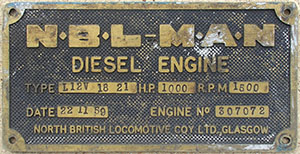Blue Pullman
Motor Cars
Power for the main and auxiliary generators was supplied by the NBL/MAN 12-cylinder vee-type supercharged diesel engine of type L12V18/21BS having a 12-hr. rating of 1,000 hp at 1,500rpm. Cylinder dimensions were 180mm bore and 210mm stroke. Other locomotives fitted with the L12V 18 21 engines at the time included the D6300 locos (rated at rated at 1530rpm) and the early Warships (rated at 1445hp).
The plate is from one of these power units. Details know for unit no. 307072 are that it was fitted in 60093 in December 1965 during a general repair at Swindon Works. It was later fitted to 60091, and on a visit to Swindon Works in July 1968 the unit was described as "throwing oil from exhaust and metal debris in sump". S. Gaskell.
Individual cylinder heads were of the pre-combustion type, provided with two inlet and two exhaust valves. Supercharging was by a Napier exhaust-gas turbo-blower mounted above the generator drive. At the free end of the engine was the crankshaft-driven pump for the hydraulic-motor fan drive. CAV fuel injection equipment and an Ardleigh governor were fitted. Lubrication priming before starting was by a Mirlees pump driven by a GEC motor. A belt-driven Dowty water pump fed the fuel service tank.

Warning lights were fitted to indicate low water level, high water temperature, low oil pressure, overload and earth fault, and the engine speed was automatically reduced to idling in the event of high water temperature, overload or earth fault. In each driving cab was fitted a general warning light and a light to indicate when an engine had stopped.
The combined engine/generator unit was mounted on a common fabricated-steel bedplate and installed on Metalastik anti-vibration mountings. The use of a quick-running vee engine results in a good power-weight ratio.
The Serck cooling group comprised vertical radiator panels in the bodyside and a roof mounted extractor fan, positioned directly behind the cab bulkhead. The 45" diameter cooling fan was driven at the correct speed to suit the cooling required by a Serck-Behr hydrostatic fan drive. The hydraulic fan motor was supplied with oil under pressure by the engine-driven pump, via a thermostatically controlled by-pass valve. Until the engine coolant reached the minimum operating temperature the pump delivery was by-passed to the oil tank: during this time the fan remained stationary. At normal operating temperatures the by-pass was closed and the resulting oil pressure rose causing the radiator shutters to open and the fan to be driven at a speed corresponding to the amount of cooling required. Access from the cab to the power compartment was through a radiator tunnel.

The main generator was a self-ventilated single-bearing machine, with windings for separately excited and self excited main fields and a series decompounding winding. This also formed part of the series excitation for motoring the generator for engine starting. The continuous ratings at 1,500rpm were 1,700A, 383V or 1,250A 523V, 650kW.
The armature shaft also carried the armature of the auxiliary generator mounted at the rear end. The ventilating fan at the drive drew cooling air through both machines. The auxiliary generator was rated at 91A, 110V 10kW, the voltage being held within close limits throughout the engine speed range by a Newton automatic voltage regulator. This generator supplied excitation for the main generator and current for starter-battery charging, control circuits and other auxiliaries.
The main generator output was controlled by an automatic load regulator, which in turn was controlled by the engine speed governor. This method of control ensured that the full engine output available at each notch setting made by the driver was maintained over a wide range of engine speeds. The power output of the generators at each end of the train was accurately synchronised. Protection against wheel slip was provided by a current limiting relay. A special form of jumper connection between cars used butt contacts to eliminate possible misalignment with the plug-and-socket type.
Summary
Development
Press run 24/6/60
Press run 7/9/60
Staff difficulties
Ownership agreement
Manufacturer's Publicity
Description
Type 1 - LMR motor car
Type 2 - WR motor car
Type 3 - WR parlour 2nd car
Type 4 - LMR kitchen car
Type 5 - WR kitchen car
Type 6 - LMR/WR parlour 1st car
Interior
Air conditioning
Motor cars
Auxiliary power
Bogies & couplings
Brakes
Data
Sub contractors
Staff instructions
LMR services begin
LMR Publicity
LMR brochure
LMR handbills
Controversy
WR services begin
WR publicity
WR publicity brochure
WR publicity leaflet
LMR Operations
WR Operations
Liveries
Rundown & withdrawal
After service & preservation
Disposal
Maintenance Manuals
Miscellaneous
Acknowledgments & Further Reading
Images
No vehicles were preserved.



